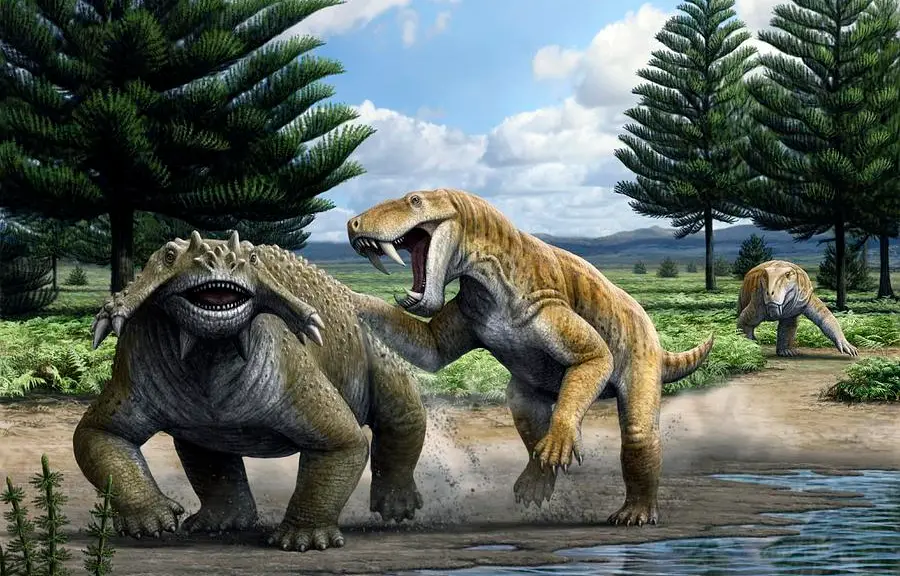Before dinosaurs ruled the Earth, at the end of the Palaeozoic Era, the land was dominated by the synapsids. The synapsids (the amniote line that includes mammals) were a highly successful group which occupied most niches during the late Carboniferous and the Permian periods, but at the end of the Palaeozoic Era most families were extinguished by the Permian-Triassic mass extinction (around 252 million years ago) with only the mammalian line surviving to the present day. In this entry we’ll look at some of the more peculiar synapsid groups, which have led to the evolution of mammals like us.
CHARACTERISTICS AND EVOLUTIONARY TRENDS
The clade Synapsida includes mammals and all other amniotes more closely related to them than to reptiles. The synapsids were the first amniotes to diversify and appeared about 320 million years ago, at the middle of the Carboniferous period. These first synapsids were characterized by the presence of only one temporal fenestra behind each orbit through which the jaw muscles pass. Synapsida literally means “fused arches” referencing to the zygomatic arches (because in the past scientist believed that synapsids had evolved from diapsid reptiles and so their arches were thought to be “fused”).
Drawing of Archaeothyris’s skull, in which we can see some of the characteristics of the synapsids, like the temporal fenestrae and caniniform teeth. Drawing by Gretarsson.
Other characteristics that appeared through their evolution were:
- Differentiation of differently-shaped (heterodont) teeth.
- Lower jaw formed by fewer bones.
- Acquisition of a more erect posture and an endothermic metabolism.
The first groups of more primitive or “reptile-like” synapsids are informally called pelycosaurs, while the latter more advanced forms are called therapsids (clade Therapsida, which in fact derived from pelycosaurs). As we will see, the evolution of synapsids is of the kind of “one group, which includes the next group, which includes the next group”.
Modified evolutionary tree of the amniotes by Kenneth D. Angielczyk (2009).
THE ORIGIN OF SYNAPSIDS, THE PELYCOSAURS
Reconstruction of Cotylorhynchus, a caseasaurian that grew up to 3 metres long. Drawing by Dmitry Bogdanov.
The first synapsids had a sprawling limb posture, low slung bodies and were probably ectothermic. If we look at the skull morphology, the earliest groups of synapsids were the caseasaurians (clade Caseasauria) characterized by their small heads, an overdeveloped snout and their huge bodies (they were probably ectothermic and slow-moving creatures). Yet, if we look at the postcranial skeleton, the earliest synapsids were two groups called the varanopids and the ophiacodontids (Varanopidae and Ophiacodontidae families) which were similar to varanids (through convergent evolution), and while the former were quite small and agile creatures, the latter developed bigger forms with huge heads.
Drawings of the varanopid Varanodon (top) and the ophiacodontid Ophiacodon (bottom). Both drawings by Dmitry Bogdanov.
Just before the appearance of the more advanced therapsids, the last two groups of “pelycosaurs” evolved and occupied most land ecosystems. Both groups shared a tall sail along their backs (similarly to Spinosaurus) formed by tall neural spines. In life, this sail probably was covered in skin and had plenty of blood vessels. Although it’s believed that these two groups were still ectothermic, this sail was probably used to gain or lose heat more easily.
Reconstruction of different species of edaphosaurids of the genus Ianthasaurus, showing their characteristic sail. Drawing by Dmitry Bogdanov.
The first of these groups is the Edaphosauridae family. Unlike most basal synapsids, the edaphosaurids were herbivorous and, along with the caseasaurians, they were among the first large amniotes to adopt a vegetarian lifestyle. The sails of edaphosaurids were covered with spiny tubercles, of which their function is still debated.
Skeleton of Edaphosaurus from the Field Museum of Chicago, where the tubercles on its spines are shown. Image by Andrew Y. Huang (2011).
The other group, the Sphenacodontidae family, were the sister group of the therapsids, inside the clade Sphenacodontia. While all other pelycosaur clades had their teeth loosely set in the jaw, the sphenacodontians had their teeth set in deep sockets. Most sphenacodontids were carnivorous, with strong jaws and well-developed caniniform teeth. Some species became the top predators on land before the apparition of the therapsids.
Reconstruction of the sphenacodontid Dimetrodon, by Dmitry Bogdanov.
THE FIRST THERAPSIDS
Skeleton of Biarmosuchus, a basal therapsid in which we can see its more erect posture. Image by Ghedoghedo.
The therapsids (clade Therapsida, “beast arches”) appeared around 275 million years ago and replaced the pelycosaurs as the dominant land animals in the middle Permian. Early therapsids already had a more erect posture, unlike the sprawling limbs of the pelycosaurs. Also, their temporal fenestrae were larger, which made their jaws more powerful.
Reconstruction of Estemmenosuchus, a dinocephalian from which fossil skin imprints have been found and so it’s known that it was covered in smooth, glandular skin without scales. Drawing by Mojcaj.
The therapsids diversified greatly and developed some extraordinary adaptations. The dinocephalians (clade Dinocephalia, “terrible head”) developed bony head knobs which are believed to be involved in some kind of head-butting behaviour. Another group, the anomodonts (clade Anomodontia, “abnormal teeth”) were characterized by having no teeth except for a pair of upper canines (which were probably covered by a beak). The anomodonts were the sister group of theriodontians.
Reconstruction of Placerias, an anomodont which could weigh up to one tonne. Drawing by Dmitry Bogdanov.
THERIODONTIA AND THE FIRST SABER-TEETH
Theriodontians (clade Theriodontia “beast teeth”) became the most successful group of synapsids. The three main groups probably looked pretty mammal-like, with fully-erect posture, a secondary bony palate which allowed them to breathe while swallowing or holding a prey and heterodont teeth (incisiviform, caniniform and molariform teeth). The most primitive theriodontian group were the gorgonopsians (clade Gorgonopsia, Gorgonopsidae family). All members of this group were carnivorous and active predators, as revealed by their sabre-toothed teeth. Although most of them were of a modest size, the larger ones reached up to 3 metres long and had canines of up to 15 cm long.
Reconstruction of Inostrancevia, the largest gorgonopsid genus, preying upon Scutosaurus, a parareptilian. Drawing by Dmitry Bogdanov.
A second group, the therocephalians (clade Therocephalia, “beast head”), were pretty more advanced than the gorgonopsians, although they didn’t reach their cousins’ size. Their feet resembled those of early mammals, they presented small pits on their bones which probably supported whiskers on fleshy lips, and most evidence suggests that they were already endotherms.
Reconstruction of a pair of Pristerognathus, a therocephalian genus in which we can see some more mammalian characteristics. Drawing by Dmitry Bogdanov.
Both gorgonopsians and therocephalians disappeared at the end of the Permian. The only therapsid group that survived through the Mesozoic period and that coexisted with the dinosaurs were the cynodonts
SMALL CYNODONTS
The cynodonts (clade Cynodontia “dog teeth”) appeared at the late Permian and diversified greatly along with the archosaurs. Although it is not really proven, most paleoartists represent cynodonts covered in fur, as evidence suggests an endothermic metabolism. Some characteristics of the cynodonts were:
- Lower jaw formed only by the dentary bone, while the other jaw bones became the ossicles of the middle ear (the articular, the quadrate and the angular bones evolved into the malleus, the incus and the stapes).
- Complex teeth: incisors to hold, canines to pierce, and premolars and molars to chew.
- Only two sets of teeth (diphyodonts), instead of constantly-renewing teeth (polyphyodonts like most reptiles).
- Large brain cavities. Some fossil burrows of different cynodonts have been found, revealing complex social behaviours.
Reconstruction of Thrinaxodon, a burrowing cynodont with whiskers and hair. Image by Nobu Tamura.
Even if they competed with archosaurs, some early forms became quite large. For example, some carnivores, like Cynognathus, had a large head and measured 1 metre long, while Trucidocynodon was about the size of a leopard. Yet, the evolutionary trend would make the cynodonts smaller, like the Brasiliodontidae family which, like most cynodonts, lived in the shadow of dinosaurs and other bigger reptiles. Brasiliodontids are thought to be the sister group of the Mammaliaformes (mammals and their most recent relatives).
Reconstruction of Brasilitherium, one of the most advanced non-mammalian cynodonts, which was only 12 cm in length. Drawing by Smokeybjb.
Finally, mammals appeared at the end of the Triassic period around 225 million years ago. The first mammaliaforms were probably, insectivorous, nocturnal shrew-like animals. It is thought that this nocturnal lifestyle is what actually propelled the development of fur coats, because in therapsids endothermy appeared before fur did. These mammaliaforms probably had mammary glands to feed their young when they had no teeth, but they probably had no nipples like current monotremes.
Live reconstruction of Megazostrodon, a small mammaliaform which represents very well the transition from cynodonts to modern mammals. Image by Udo Schröter.
After the extinction of most archosaurs at the end of the Cretaceous period, the surviving synapsids took over the empty ecological niches. Mammals have ruled the world since then, conquering the land, the sea and even the air, but it wouldn’t have been possible without all the different adaptations acquired by early synapsids throughout their evolution. Thanks to them, humans and all other mammals are currently the dominant animals on the planet.
REFERENCES
The following sources have been used during the elaboration of this entry:
- http://tolweb.org/accessory/Synapsid_Classification_&_Apomorphies?acc_id=466
- http://www.tandfonline.com/doi/full/10.1080/14772019.2011.631042
- http://journals.plos.org/plosone/article?id=10.1371/journal.pone.0094518
- http://www.eurekalert.org/pub_releases/2015-10/sovp-ans102915.php
- http://www.tandfonline.com/doi/abs/10.1080/02724634.2011.627074
- http://dibgd.deviantart.com/gallery/
- Cover image by Mauricio Antón.



One thought on “Synapsids: Before dinosaurs ruled the Earth”